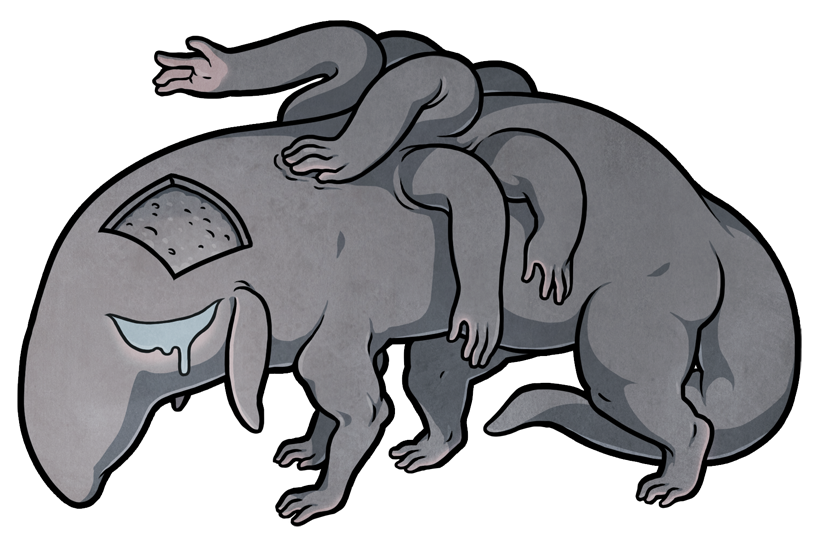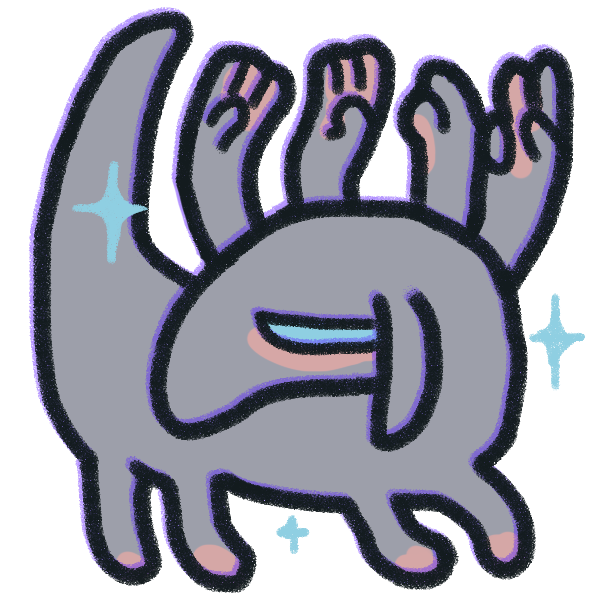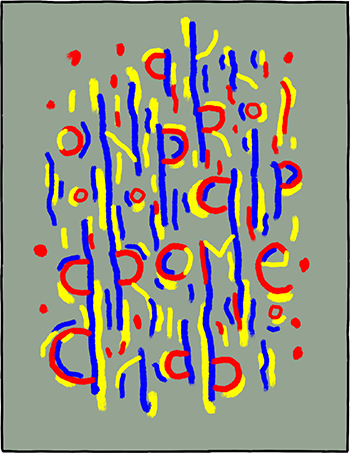

Ondridrome
the Veterans
prefix ondri suffix drome
preduleus nostra
physical appearance
The ondridrome /ˈɒndrədroʊm/ is a lumbering stranger with a fleshy, wide-framed form. It can be characterized by the two to four arms that grow upwards from its back, in addition to the four legs that carry it as it movies. An additional pair of small, floppy, ear-like appendagesფ hang from the sides of its head. Its soft skin smells of musty newsprint, and leaves behind a fine powder on any surface with which it comes into contact. Although the ondridrome's coloration is marked by varying shades of grey, subtle pink or reddish hues are apparent around the hands, feet, mouth, and underneath its "ears". The doughy inner flesh, meanwhile, is uniform throughout.
ფ Stuffed animal ears.
above: minor variations in drab hues.
When injured, the rate of regeneration varies between individuals. Some ondridrome heal almost instantly; others requires months, if not years, to fully recover. Scarring, similarly, ranges from nearly indiscernible discoloration, to jagged raised lines across the stranger's surface. Though the strain resists cold temperatures, it appears subtly poisoned by both extreme heat and high humidity, with some temporary wrinkling of the skin around the hands and ears.
Despite its great bulk, the ondridrome's soft, padded hands and feet allow it to move without making a sound, even over rocks and gravel. It speaks in a quiet voice that is subdued, but familiar, resembling the weary mutters of an aged human. Nearly half (50.1%) of ondridrome speak with a deep voice, while 49.9% speak with a voice that is higher in pitch. It never speaks as long as there is a louder sound nearby.
Hmmm........ohhhh, hmmmm.

environment and generation
The ondridrome appears in a wide range of outdoor residential locations, but prefers the narrow side streets, community gardens, and alleys of back driveways found in some residential neighborhoods. The ondridrome does not generate while around human beings, and as such, specifics of its initial manifestation remain unknown. It never appears in areas with more than minimal commotion or activity.
behaviour
The ondridrome's disposition is listless and apathetic, and it shambles forward with trudging steps, like a haggard pensioner suffering from countless untold aches, stopping every so often to grumble, or to let out a tired sigh. It uses the arms on its back to scratch at its ears, pick off dirt from its skin, and push away branches or other obstacles from its path. Tending to stay within a small, specific territory, the stranger dislikes changes within its environment. Once an area becomes too active for its tastes, it migrates towards a quieter locale, and grows ill when unable to find a suitably peaceful environment.
everyone else already knows

are you having a little problem with the "homeless"?
you don't have to feel embarrassed, it's not your fault! we have the solutions you need - industrial spikes, flood lights, high-frequency tones, concrete barricades, poisonous plants, distance activated pesticide sprays, and for a price... solve your humiliating problem, make it go away! «¢ «¢ ¼¢ ¢


Despite its depressive nature, the ondridrome is not without its small pleasures, and displays some interest in random, minute details of the world around it. It listens to soothing songs from beneath open windows, cocks its head at flickering lights, and chuckles when certain birds and insects land on its back.
It is not markedly social.
shrine-building
The ondridrome seeks out and gathers objects within its territory. The criteria by which these objects are selected varies between individuals; some ondridrome seek out specifically-colored objects, while others are drawn to objects of a certain shape, and still others prefer particular textures or materials. In addition, three percent of ondridrome seek out objects based on weight or length. One ondridrome might, for example, only seek out objects which weigh exactly 21.84 pounds, while another might find itself drawn to objects with a width of exactly seven inches at the widest point. The ondridrome seems able to sense these properties intrinsically, without the need to measure or pick up an object to test its weight or size. Only one percent of ondridrome select objects which do not seem linked by any immediately identifiable criteria, although it remains unclear whether these "dissimilar" objects are selected at random, or share a secret, unknown commonality. No ondridrome, however, selects objects longer than two feet long at the widest part, or heavier than 38 pounds.
Once it has found an object that fits its criteria, the ondridrome picks it up with one of the arms on its back and carries it to a specific locationდ within its territory. It places collected objects with care, arranging them into "shrines" in these locations. Objects are always meticulously arranged, although an ondridrome's arrangement of objects does differ from standard human placement and use. Books, for example, might be propped up on their edges like tents, whilst small statues might be placed so that they face backwards, or lay on their sides. The ondridrome never modifies or destroys objects in any way, and takes great care to rearrange its shrines many times over as new objects are added. The ondridrome also rearranges its shrines when objects are scattered or repositioned due to outside forces, and removes objects which have been modified to no longer fit the ondridrome's criteria for selection.
დ
a a gap between two dumpsters.
b the bumper of a parked car.
c an alcove in the wall of a building.
The ondridrome does not react when its shrine is completely removed, and it takes no time before starting on a new one.
it's true, isn't it?


hey, that's not art...!!!
have you ever thought, "my four year old could have drawn that!!"? you can find out how to defund art grants, shut down funding for museums, make them earn a real living now! © »
Shrines are considered complete once a set number of objects have been collected. This number varies between individuals, but is always a multiple of nine, ranging between nine and 999. Once this number of objects is met, the ondridrome nods and emits a slight murmur of satisfaction. Its "mood" quickly shifts back to sobriety, and it begins its slow wander into a neighboring area, where it builds a new shrine.
Half of one percent of ondridrome appear to seek out objects by a criteria which no natural object is able to match (for example, objects composed entirely of neon molecules, or items weighing -0.5 pounds each). These individuals wander forever, their hands always empty and their shrines un-built, but appear no more or less weary than their more fruitful companions.
The ondridrome does not display much regard towards others of its strain, although quarrels can occur when one individual takes an object from another individual's shrine. These fights, which consist of much shoving and grumbling, are short, half-hearted, and cause no ultimate injuries, with the smaller ondridrome giving up after several minutes.
A small minority of ondridrome (0.02% of individuals) displays affirmative reactions towards 0.4% of objects, which elicit a breathy chuckle. An ondridrome which displays this behaviour pushes these objects into its own flesh, where they remain for the rest of the stranger's life. An ondridrome never pushes more than five objects into its body, however, and once five objects have been embedded, this "disingenuous humor" behaviour does not recur.
interest in corpses
Whenever the ondridrome discovers a human corpse, the edges of its lips curl up into a slight, self-satisfied smile, and it lets out a sigh of relief. It then drags the corpse back to its shrine, where it rearranges all objects so that the corpse can be the centerpiece of the shrine's arrangement, often with objects placed inside the mouth, nostrils, and over the eyes of the corpse. When the body possesses large wounds, objects are always placed insideɥ these holes or gashes.ე The ondridrome never does anything that causes harm to these corpses, and, in fact, appears greatly distressed when the corpse is removed, when decomposition sets in, or when damage does occur due to scavenging strangersɰ or feral animals.
ɥ "Placed inside"...more like they're stuffed in as far as they can go.
ე It wants to fix it the only way it knows how.
ɰ You mean, like a wandering gourmand?
interactions with sensitives
The ondridrome displays shyness towards sensitives, hiding behind nearby walls or objects when approached. It does not appear to take its large size into account when selecting these hiding spaces, and mostly seems concerned with hiding its face. As such, it is not uncommon for the ondridrome to shield itself behind trash cans or recycling bins which do not conceal the entirety of its bulky form.
Once a hiding spot has been chosen, the ondridrome remains stationary, even as the sensitive walks closer. When calmly approached by a sensitive with quiet demeanor, the ondridrome does allow some handling; it seems to like slow, gentle strokes on its head, and emits a slight "ahh" sound following such contact.
Firm impacts cause an ondridrome's fleshy body to harden to the consistency of cement. As such, it is difficult to kill when in this state, as it can only be destroyed by impacts strong enough to crack stone. Furthermore, it must be broken apart into pieces to be killed, as the ondridrome's putty-like, regenerative form allows it to heal from partial wounds once it re-enters a softer state. The ondridrome remans in this statue-like form until its attacker leaves the area, at which point its texture begins to yield. Once its flesh is fully softened, the ondridrome shakes a layer of inevitable dust from its skin, and returns to its usual activities.
Although not directly hazardous, proximity to the stranger causes weariness and muscle soreness in both sensitives and non-sensitives alike, the effects of which require several days of rest and relaxation to alleviate. The human body neutralizes this effect within one to three weeks exposure, and individuals which live near ondridrome display little to no lasting negative effects.
aging and death
As the ondridrome ages, it slows down, and its behaviour grows more languid and absent-minded. It no longer gathers objects in shrines, but rather, places them at random in its surroundings – in the tailpipes of cars, on doorsteps, or in open mailboxes. As the months span on, it grows clumsier in a slow and steady decline, eventually losing the ability to hold ontoკ objects in its hands.
კ It drops them, and it doesn't seem to notice.
Death comes suddenly. At the end of the ondridrome's life, it lays down with a weary sigh, and its body lapses into inanimacy with little fanfare. The corpse first turns dry, then powdery, until it breaks apart into a pile of dust and ash after one to two hours. Other ondridrome place offerings near these ashy piles, and pay no mind to the dust from their fallen companions; the dust leaves a chalky residue on the soles of their soft but heavy feet.

doesn't actively try to ruin my day
I found a nice set of ceramic plates in one of the shrines
I hate when it's dragging some dead body around
you start to notice that "old person" smell if you let it touch your stuff
now listing: posts containing "ondridrome"
my doctor said it was "depression and anxiety"
@ ▚▙▙▝/▝▞/▙▜ at 06:24AM
My clothes smell like a strange old man. hug it with caution.
@ ▚▝▝▘/▛▚/▜▗ at 10:03AM

